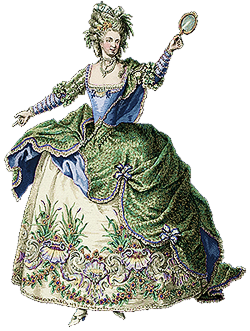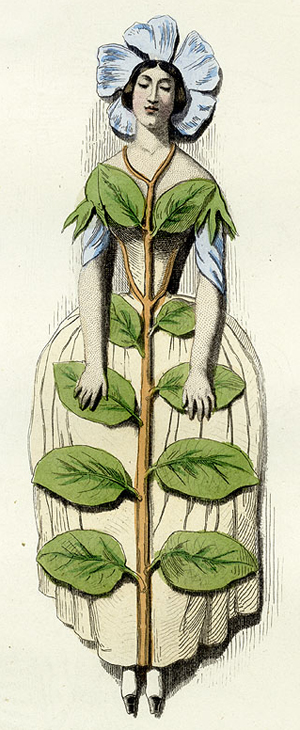| |
The Genus Vinca - from the Latin 'vincire' meaning 'to bind' - is the genus of six species. Invasive though Periwinkle can be, this gives it an advantage where disturbed ground is concerned, such as in graveyards where it often thrives. This fact cinches its association with death; wherefore it is used in various European cultures for funeral rites, especially for those of children. This association with death further links it to spirits, and imbues it with perceived magical powers. The manner in which it covers grave plots can be seen as protective, and Welsh folklore warns that anyone foolish enough to pluck a Periwinkle flower from a grave will surely be haunted. Yet for those who respect the Periwinkle, it will protect them against the dead and necromantic witchcraft, allegedly having the power to exorcise devils. Periwinkle is often woven into a wreath that may be hung upon the front door to protect the household. It is encouraged that wary travelers carry with them some Periwinkle, the guard against such ill fortune as thieves and wild animals.
Whereas the Periwinkle in Italian is called either 'centocchio' meaning 'a hundred eyes or 'fior di morto' meaning 'flower of death,' in German it is known as 'blume der unsterblichkeit' or the 'Flower of Immortality." The French call it 'violette des sorciers' or 'sorcerer's violet.' In North America it is often known as 'Creeping Myrtle,' although of no relation to actual myrtle.
The Victorian language of flowers equated it with fond memories and friendship, a notion derived from
the writing of Rousseau, who through the Periwinkle was able to recall a forgotten friendship. Commonly given in boquets before trips it communicated the hope that the recipient remember fondly whoever is remaining behind.
The leaves of the Periwinkle are stuffed into a couple's mattress to improve marital issues, such as fidelity, love, passion and overall happiness. It was encouraged to grow around a family's home, promoting harmony such as it does.
From the above examples we can see how Periwinkle can be used in association with Death, protection, memories, and relationships. Quite a lot influence for such a common flower.
|

FLOWER SORCERY

A Spell To Illicit Fond Memories
|
We all have relationship that over time become difficult, too often ending in a divorce of marriage or friendship. It can be difficult to remember all the good times, yet Periwinkle can come to our aid by helping more of those fonder memories arise.
For this spell you need only two things, a Periwinkle flower, and the following verse.
|
Help us now recall the time
When [so-and-so's] laughter merged with mine
And may that joy repeated be
In present mind and memory
|
This verse is spoken to the flower, however the word 'us' relates to you and whoever you are having an issue with. When you have finished this spell you will want to press your flower. Periwinkles do not take much to effort to press, so placing it between the pages of an old book should suffice. It is nice to have an old book of poetry of such to keep such flowers in. It should remain preserved, just as your fond memories should also.
|
|
Please note: The spells contained on this page are not intended as a substitute for any legal, financial, psychiatric and or medical services.
|
|
PERIWINKLE IN MAGICAL TEXTS
|
For Fidelity
&
Blue Fire
From
The Boke Of Secretes Of Albartus Magnus
Of The Vertues Of Herbs, Stones And Certaine Beastes
|
"Perwynke when it is beate unto pouder with worms of ye earth wrapped about it and with an herbe called houslyke, it induceth love between man and wyfe if it bee used in their meales . . . if the sayde confection be put in the fyre it shall be turned anone unto blue coloure."
Editors Note: The word 'houslyke' likely refers to sempervivum tectorum, of the Crassulaceae family, which is a succulent native to Asia, the Middle East and Europe. Thatched European houses served as an environment for the House Leek, which is also called 'live-forever.'
I have not tried this formula, mostly because my grocery store does not carry 'pouder of worms of ye earth,' and I'm admittedly reluctant to powder them myself. I am however intrigued by the three ingredients being related to the Underworld (worms), Terra Firma (periwinkle) and the Heavens (house leek), which likewise reflect aspects of the Three Souls, which I find to be a common element in many magical formulas and relevant towards a Faery Tradition modus operandi for spellwork.
|

PERIWINKLE
IN FOLKLORE
|
Matthias Night
|
 |
On Matthias night (Feb. 24) the young people meet, the girls plait on wreath of periwinkle, one of straw, and as a third they carry a handful of ashes; at midnight they go silently to a running stream, on which the three things are to float. Silent and blindfolded, one girl after another dances about the water, then clutches at a prognostic, the periwinkle's meaning a bridal wreath, the straw misfortune, the ashes death. The lucky ones carry the game further, and throw barleycorns on the water, by which they mean certain bachelors, and notice how they swim to one another. In other cases three leaves are thrown on the water, marked with the names of father, mother and child, and it is noticed which goes down first. -Grimm
|
In Western Ukrainian weddings the bride and groom are crowned with wreaths woven of periwinkle. The crown symbolizes how they are to become rulers of their own household, whereas the periwinkle is chosen for its association with fertility in Ukrainian folklore.
Periwinkles used to be put close to all those things that it was desirable to have lasting as long as possible, for example, newborns and candles. Periwinkles at the side of the newborn baby would thus help ensure the baby’s long life, and periwinkles arranged around candles lit at the wedding would help keep the love of the newlyweds “evergreen.” -Ukranian Tourism Guide
|
|
PERIWINKLE IN MYTHOLOGY
|
The English botanist and herbalist Nicholas Culpeper considered these plants to be something of an aphrodisiac when shared amongst lovers, as he concluded that the goddess of love, Venus, grew and kept these plants.
|
|
|

PROSE & POETRY
Gentle vines that intertwine
A lover’s sweet embrace
A god within, the sky blue djinn
To chaos, bring now grace.
-
Storm Faerywolf |
'Parwynke is an erbe grene of colour
In Tyme of May he beryth blo flour,
His stalkys ain so feynt and feye
Yet never more growyth he hey.
And we are also told that 'men calle it ye Juy of Grownde.'
-Macer
|

Periwinkle for Tender Recollections
|

Click image above for a larger view. |
"In France, the Periwinkle has been adopted as the emblem of the pleasures of memory and sincere friendship, probably in allusion to Rousseau's recollection of his friend, Madame de Warens, occasioned, after a lapse of thirty years, by the sight of this flower, which they together had admired. This plant is deeply rooted in the soil which it adorns. It throws out its shoots on all sides to clasp the earth, and covers it with flowers, which reflect the hue of heaven. Thus our first affections, warm, pure, and artless, seem to be of heavenly origin."
|
As Simon Fraser was lead through the streets of London towards his execution in 1305 he was crowned with a wreath of Periwinkle, a common form of public mockery especially directed at those believe to have reached far beyond their station. |

The lesser Periwinkle's bloom,
Like carpet of Damascus' loom,
Pranks with bright blue the tissue wove
Of verdant foliage : and above
With milk-white flowers, whence soon shall swell
Red fruitage, to the taste and smell
Pleasant alike, the Strawberry weaves
Its coronets of three-fold leaves
In mazes through the sloping wood.
-Mant
|
 |
Where captivates the sky-blue Periwinkle
Under the cottage eaves.
-Surdis
|
Rousseau mentions an example of the tenacity with which early impressions are retained—"Walking one day with Madame Warens, she exclaimed, 'O! There is the periwinkle still in bloom!' Till then I had never seen the periwinkle, and being too shortsighted to distinguish plants without stooping, merely glanced at the blue flowers growing under the hedge; but so deeply was every circumstance connected with that period impressed upon my memory that, thirty years later, when botanising with a friend, I came suddenly upon the periwinkle, and although I had never met with it during the interval, I at once joyfully recognised it." -McCaw
|
Image right: "Periwinkle" by J. J. Grandville 1867 |
|
|
BOTANICAL INFORMATION
|
The plant is perennial and retains its glossy leaves throughout the winter. Occasionally, in the smaller kind, when cultivated in gardens, leaves occur with streaks of lighter green upon the dark rich colour that is characteristic of the rest of the foliage. The leaves are always placed in pairs on the stem, the flowers springing from their axils. In the Greater Periwinkle, the leaves are large and egg-shaped, with the margins minutely fringed. Those of the Lesser are much smaller, myrtle-like in form, their margins not fringed.
The flowers of the Periwinkle vary somewhat in intensity of colour, but the average colour is a deep purplish-blue. A white variety of the Lesser Periwinkle occurs in Devonshire and in gardens; it is often met with bearing purple, blue and white flowers, sometimes double.
The calyx is deeply cleft into five very narrow divisions. The corolla consists of a distinctly tubular portion terminating in a broad flat disk, composed of five broad lobes, twisted when in bud, curiously irregular in form, having the sides of the margin unequally curved, so that although the effect of the whole corolla is symmetrical, when each separate lobe is examined, it will be seen that an imaginary line from apex to the centre of the flower would divide it into two very unequal portions - very unusual in the petals of a flower. The whole effect is as if the lobes of the corolla were rotating round the mouth of its tube, and the movement had suddenly been arrested.
The mouth of the tube is angular and the tube closed with hairs, and the curiously curved anthers of the stamens, which are five in number, are inserted in the tube. The pistil of this flower, as well as of the smaller species, is a singularly beautiful object, resembling the shaft of a pillar with a double capital. The anthers stand above the stigmatic disk, but the stigma itself is on the under surface of the disk, so that self-fertilization is not caused as the insect's tongue enters the flowers.
The Lesser Periwinkle is not only smaller in all the parts, but has a more trailing habit of growth, matting itself together. The stems are very slender, only those bearing flowers being erect, growing to a height of 6 to 8 inches, the others trailing and rooting freely at intervals, so that a large space of ground is quickly monopolized by it. -Grieve
|

|

 |





